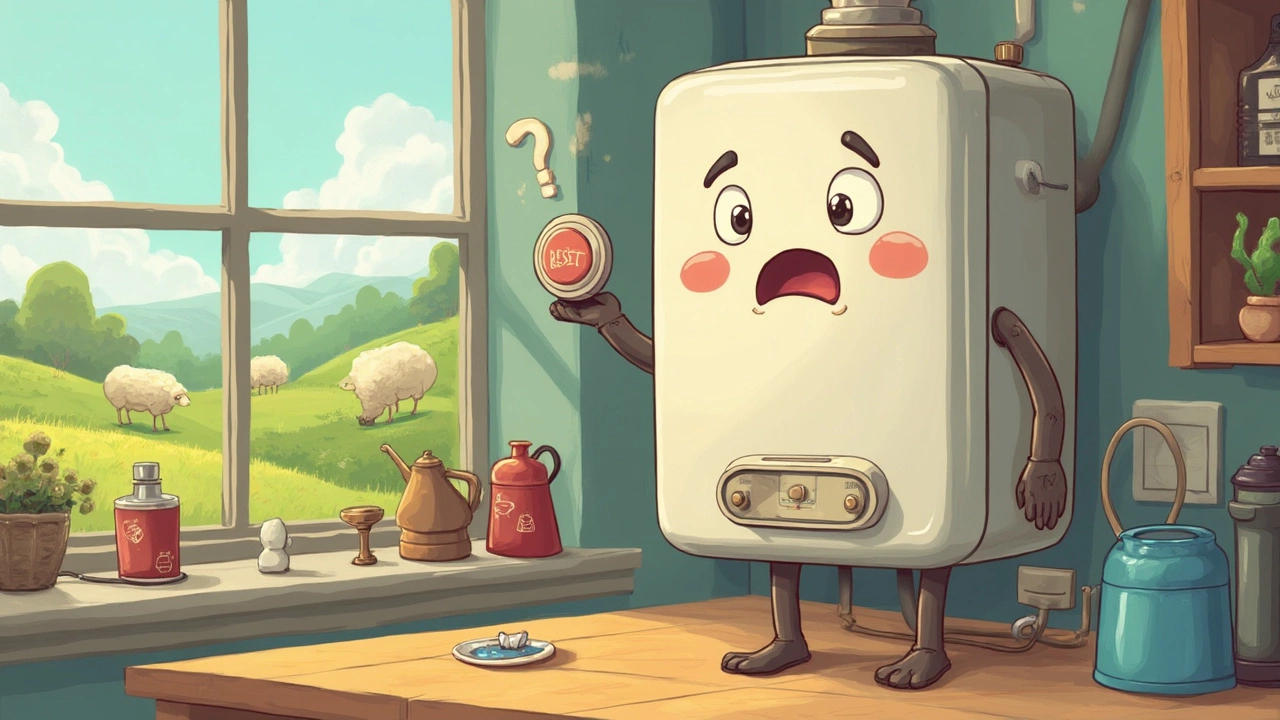Okay, so you've suddenly been hit with an ice-cold shower, and not because your morning playlist is chill. It might just be your hot water heater acting up. Cold showers are nobody's favorite Monday surprise, but before you panic, a simple reset could be all you need to get things back to delightfully warm.
First off, how do you know it's time for a reset? If your water heater isn’t producing hot water, or if the water temperature is inconsistent, it’s likely time to push that reset button. You’d be surprised how often this trick works, kind of like magic, but rooted in engineering.
Just a heads-up, different heaters have different reset processes. However, the common denominator is safety. Always turn off the power supply before you begin tinkering. Seriously, it’s not worth getting zapped over a bit of hot water.
- When to Consider a Reset
- The Basics of Hot Water Heaters
- Safety First: Precautions to Take
- Step-by-Step Guide to Resetting
- Common Problems and Fixes
- Maintenance Tips to Avoid Future Issues
When to Consider a Reset
Your hot water heater isn't just a fancy tank; it’s a bustling hub for your household comfort. Knowing when to reset it can save you from chilly surprises. Ideally, you’d want to hit that reset button if you notice a few telling signs.
Cold Water Shock
If you’re getting cold water when you should be feeling the warm soothing flow from your shower, it's likely time to consider a reset. This situation is the most obvious sign that your water heater might be crying out for a little restart.
Inconsistent Temperature
One day it’s hot, the next it’s not—if your heater is playing a guessing game with water temps, a reset might help to stabilize things.
Strange Noises
Banging, popping, or hissing noises are not normal unless you have a poltergeist in your pipes. However, usually, they mean your water heater might need a reset or some deeper troubleshooting.
Energy Bill Spikes
Sometimes, your energy bill can spike without a change in usage. This might indicate your water heater is overworking due to a fault that a simple reset can fix.
| Problem | Potential Outcome |
|---|---|
| Cold Water | Time for a reset |
| Inconsistent Temps | Consider resetting |
| Loud Noises | Check if reset solves it |
Remember, if the reset doesn’t fix the issue, there may be more significant faults, like a failing thermostat or heating element. Always consult a professional if things don't get back to warm and cozy.
The Basics of Hot Water Heaters
Let's dive into what makes these marvelous appliances tick. A hot water heater is like the unsung hero of our homes, quietly keeping showers, dishwashers, and washing machines running smoothly. But what's going on behind the curtain?
In most modern homes, you'll find either a tank-type or a tankless water heater. The tank-type is the most common—think of it as a big thermos holding ready-to-use hot water. It has a thermostat to control the water temperature and uses gas or electricity to heat the water.
Tankless heaters are a little different. Instead of holding a bunch of hot water, they heat water on demand. This means they can be more energy-efficient, but they might struggle if you're running a shower while also doing two loads of laundry.
Types of Energy Sources
As far as energy sources go, water heaters often run on either natural gas or electricity. Gas heaters tend to be cheaper to run, but the installation can be pricier. Electric models are usually cheaper upfront but could cost more over the long haul due to energy costs.
- Gas Water Heaters: Uses a burner at the bottom to heat the water.
- Electric Water Heaters: Rely on heating elements inside the tank.
Basic Components
Most hot water heaters share a few core elements:
- Thermostat: This controls the temperature at which your heater operates.
- Pressure Relief Valve: A safety feature to prevent excessive pressure build-up.
- Anode Rod: Helps prevent rust inside the tank.
You usually find the reset button near the thermostat—a small but mighty feature. If your heat disappears, this is your first stop. And remember, if you're ever in doubt, don't hesitate to call a professional to check out your water heater.
Safety First: Precautions to Take
When tackling a reset of your hot water heater, safety isn’t just a suggestion—it's essential. You don't want your water heater experiment turning into a shocking tale quite literally!
Switch Off the Power
This one's a no-brainer, but hey, it's worth repeating. Before you do anything, turn off the power to the unit. Most electric heaters have a dedicated breaker. Head to your electrical panel, and find the corresponding switch. Make sure it's firmly off before you even touch the heater.
Check for Leaks
While you're there, give a quick once-over for any obvious leaks. A leaky water heater can be a slippery and potentially damaging situation. If things look damp or there's a puddle forming, it’s best to call in a professional before proceeding.
Cool Down
Water heaters can get, well, hot. Allow the heater to cool down a bit, especially if it was running just before you decided to reset it. It could save you from a nasty burn.
Lock the Doors
Kids and pets love to investigate what you're up to. Make sure your workspace is secluded. Shut doors or use gates to keep curious little ones and furry friends safe.
Taking these precautions means you're starting your hot water troubleshooting adventure on the right foot. Remember, there's no such thing as being too careful when dealing with electricity and water.

Step-by-Step Guide to Resetting
Resetting a hot water heater might sound daunting, but it's actually something you can tackle with a bit of patience and the right steps. So grab your toolbox and let’s dive in—it’s easier than you think!
1. Turn Off the Power
This is crucial. Find your breaker panel and locate the switch for your water heater. Flip it to the “off” position. This ensures your safety while you're poking around the internals.
2. Access the Reset Button
Locate the water heater unit—typically, the reset button is behind a panel. Unscrew the panel using a screwdriver. Once exposed, you might need to peel back some insulation to spot the bright red reset button.
3. Press the Reset Button
Press the reset button firmly. You might hear a click, which is a good sign. This usually means the heater is ready to come back to life, resetting any faults that caused it to shut down.
4. Reassemble the Panel
Carefully replace the insulation, re-screw the panel, and make sure everything looks like how it did before.
5. Restore Power
Head back to the breaker and turn the power back on. This is the moment of truth. Once the power is restored, wait about 30 minutes and check if your showers are back to their toasty selves.
Troubleshooting Tips
If the reset doesn’t work, there might be bigger issues at play like a thermostat or heating element failure. It might be time to call in the pros if it's still wonky.
By the way, did you know about 10% of households report hot water heater problems yearly? A reset fixes issues for a good number of them.
Common Problems and Fixes
Even the best hot water heaters can hit a snag now and then. Fortunately, most issues have straightforward fixes. Let's break down some usual suspects and get you armed with solutions.
1. No Hot Water
If your unit’s giving you nothing but cold water, your circuit breaker might have tripped, or maybe the thermostat is acting out. Here’s what you should try:
- First, check the circuit breaker panel and reset hot water heater circuit breaker, if needed.
- Inspect the thermostat setting. That little dial can sometimes move on its own.
- If neither works, the heating element might be faulty. A call to a qualified technician could save you here.
2. Inconsistent Water Temperature
Fluctuating water temperatures can be a real pain, especially during that perfect shower. The main culprits might be:
- Fluctuations in the thermostat. Adjust it again for stable temps.
- Build-up of sediment in the tank, reducing efficiency. You might want to flush out your tank. Most suggest doing this twice a year.
3. Water Heater is Leaking
No one wants their basement or utility room flooded. Leaks can happen if:
- A loose drain valve is to blame. Tighten it, but don’t overdo it.
- Corrosion or dents have damaged the tank. An immediate replacement might be necessary.
4. Strange Noises
Is your water heater suddenly part of a percussion band? Those sounds often mean sediment buildup:
- Perform a quick flush-out to clear sediment. This should calm things down.
- If sounds persist, a faulty heating element could be the issue.
Problem-solving your hot water heater can feel like tracking down a stubborn culprit. But, hey, a bit of patience and some know-how go a long way in keeping the warm water flowing!
Maintenance Tips to Avoid Future Issues
Keeping your hot water heater in top shape isn't rocket science, but neglect can turn it into a major headache. Regular maintenance can do wonders for extending its lifespan and ensuring it runs efficiently. Here are some practical tips to keep your hot water heater happy.
1. Regular Flushing
First up, flush your water heater at least once a year. This prevents sediment buildup, which hampers efficiency and might cause corrosion. Sediment loves sitting at the bottom of the tank, slowing heating and eventually leading to rust. By flushing, you not only clean it out but also keep your heating cost in check.
2. Check the Pressure Relief Valve
The pressure relief valve is crucial to the safety of your hot water heater. Test the valve once a year to make sure it's not stuck. Simply lift the lever and let it snap back. You should hear a rush of water, indicating it's working fine. If not, consider replacing it to avoid potential disasters.
3. Inspect the Anode Rod
Look for the anode rod every couple of years. This little component attracts all the corrosive elements in your water, sacrificing itself to protect the tank. If it's less than half an inch thick or coated with calcium, it's time for a replacement. An intact anode rod can add years to your tank's life.
4. Maintain the Temperature
Keeping your water heater temperature around 120 degrees Fahrenheit is a sweet spot. It prevents scalding, reduces energy bills, and lessens the chance of overheating. It's a simple step that pays off in the long run.
5. Insulate the Tank
Adding an insulating blanket around your hot water tank can save energy by reducing heat loss. It's especially useful for older tanks and can reduce standby heat loss by as much as 25-45%. Add some foam insulation around the pipes to boost efficiency, especially if they're in unheated spaces.
Keeping up with these maintenance tips not only helps in avoiding an unexpected reset but also maximizes your heater's efficiency and lifespan. Just a bit of annual TLC can work wonders!





